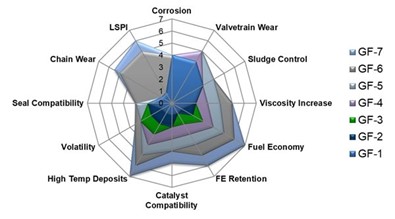The landscape of passenger car motor oils (PCMO) is set for a significant transformation with the introduction of the new ILSAC GF-7 specifications. Expected to take effect in the first quarter of 2025, these updated standards promise to bring about substantial improvements in performance and environmental impact, positioning them as a pivotal advancement in the field of automotive lubrication.
Key Improvements Under ILSAC GF-7
- Enhanced Fuel Economy
Among the most notable changes with the GF-7 specifications is the emphasis on improved fuel economy. This shift addresses growing demands for more efficient energy use in vehicles. The new standards aim to deliver better fuel consumption rates, which ultimately reduces the overall cost of ownership for motorists, and contributes to lower greenhouse gas emissions. - Superior Engine Protection
The GF-7 specifications introduce stringent requirements related to piston deposit control and aged oil low-speed pre-ignition (LSPI) mitigation. By enhancing these parameters, the new standards ensure that engines remain cleaner and more efficient over extended periods. This improvement not only boosts engine longevity but also enhances overall vehicle performance.
- Aged Oil Performance
GF-7 also focuses on maintaining oil effectiveness over longer drain intervals. The improved resistance to oxidation and thermal breakdown ensures that motor oils continue to perform optimally throughout their lifespan. It also offers better protection against wear and tear.
Strategic Implications for PCMO Manufacturers
- Compliance and Competitive Advantage
For PCMO manufacturers like U.S. Lubricants, aligning with the GF-7 specifications will be crucial. Those who can rapidly adapt their formulations to meet these new standards will gain a competitive edge, positioning their products as top choices for consumers seeking enhanced performance and eco-friendliness. We are currently working to identify our formulations and chemical partners so we can align with GF-7 when it goes into effect. - Innovation and Technology Integration
The transition to GF-7 provides an excellent opportunity for integrating advanced technologies into motor oil formulations. By leveraging cutting-edge additives and base oil technologies, manufacturers like U.S. Lubricants can achieve the enhanced performance metrics required by the new specifications. This focus on innovation will likely drive further advancements in the industry, setting new benchmarks for quality and efficiency.
- Market Dynamics
As the market gears up for GF-7, we can anticipate a phase-out of last generation oils that no longer meet the revised criteria. This shift will help elevate overall product quality within the market, ensuring that consumers have access to superior lubrication solutions.
Conclusion
The introduction of the ILSAC GF-7 specifications marks a significant milestone for the PCMO market. With its focus on enhanced fuel economy, superior engine protection, and sustained oil performance, GF-7 sets a new standard for excellence in automotive lubrication. For manufacturers like U.S. Lubricants, this represents both a challenge and an opportunity to innovate and lead in a rapidly evolving market. As consumers increasingly prioritize efficiency and sustainability, those brands that can effectively meet these new specifications will stand to benefit considerably.
By embracing the new GF-7 specifications, the PCMO industry can look forward to a future characterized by higher performance, greater reliability, and a reduced environmental footprint. However, you don’t have to wait until 2025 to give your automotive customers the high-quality lubricants they deserve. Contact us to discuss quality lubricant solutions available today, that meet your budget and delivery needs.










































